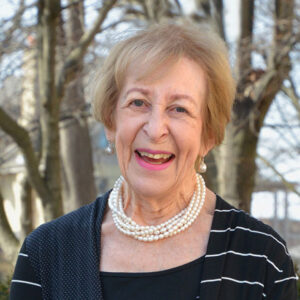

VIEWPOINT
Looking back on a clinical academic career: a woman physician’s leadership journey
![]()
Sandra Fisman, MB
 This invited article provides a retrospective composite of the experience and some of the choices made during a clinical academic career. I reflect on joys and challenges experienced through the years and seek to advise young physicians who are on the threshold of a medical career.
This invited article provides a retrospective composite of the experience and some of the choices made during a clinical academic career. I reflect on joys and challenges experienced through the years and seek to advise young physicians who are on the threshold of a medical career.
Fisman S. Looking back on a clinical academic career: a woman physician’s leadership journey. Can J Physician Leadersh 2025;11(3): 156-164. https://doi.org/10.37964/cr24800
I have learned a lot over my long career as a clinical academic leader. Being a pragmatist, I will try to synthesize what may be the most valuable lessons for you, as current and future leaders, who can move our health care system to a better place.
I have enjoyed a productive career as a child and adolescent psychiatrist and senior administrator. In particular, I have been passionate about my work with children, youth, and families and have experienced joy in changing the developmental trajectory of troubled and troubling young people to happy and productive citizens.
I was born at the tail end of the “traditionalist generation” and on the brink of the “baby boom.” So, it will not come as a surprise that my early role models were two women physicians, living and working in the traditionalist era. They had each managed to combine successful medical careers with child rearing and maintaining a household. One of these women held a leadership position as head of an anesthesiology department in a large academically affiliated hospital. The other was a pediatrician in a community hospital. These women were clearly ahead of their time, and both lived into their early nineties.
My story of development as a female clinical academic is an intertwined narrative between my personal life and my career. In the course of my life and work, there have been progressive changes for women in terms of gender equity, particularly at the leadership level. Beginning in the 1970s, we have seen many changes in female prominence in the professions, including medicine.
Enrolment of women is much higher in what were traditionally male-dominated professions: medicine, law, architecture, and engineering. There has been growth and more acceptance in places where women had not previously been welcome, such as surgery and the surgical subspecialties. However, a gap remains between the percentage of women who have entered these positions and those who have gained senior positions. Data still indicate that women medical school faculty are promoted more slowly than men. Gender differences are not explained by hours worked or time since graduation.1
With this backdrop, what helpful advice can I share with young people embarking on an academic career? I believe that we still have an important task ahead of us. This involves the need for a real change in our academic culture to allow people of all genders to thrive. Such a culture shift is premised on the universal adoption of a values-based framework that embraces collaborative, mutually respectful relationships, including trust and promotion of personal integrity.2 It is these relationships that have the greatest chance of taking us to an academic win-win common ground.
In a practical sense, being part of a culture and values transformation requires that newly hired academic faculty seek out the right mentoring and role modeling early in their academic career. A successful mentorship relationship requires a genuine commitment to the process, adequate time spent together, and syntonic role modeling by the mentor.3 Same-gender role models are necessary for all genders in the early phases of their career development, but generally with academic growth there is a need for more than one mentor who may or may not be of the same gender.
In fact, the blurring of stereotypical gender role behaviour, which we have been able to talk about so much more comfortably over the last decade, will allow us to make progress in trusting one another and accepting our differences. Thus, the stereotypically male characteristics of competitiveness, ambitiousness, and assertiveness are important for success in competitive areas. However, tempering these with stereotypically female characteristics of flexibility, being more nurturing, sharing information, and supporting others is valuable in generating heathy personal and organizational growth.
Let me turn to some personal advice for those on the threshold of an academic career in medicine. It may not resonate for everyone as you set your career direction. Feel free to pick and choose and have the courage to shift direction in mid-career if your aspirations change. Ultimately, the best balance will come from your personal choices and your passion about those choices.
I would like to begin with medical leadership. There is no question in my mind that leadership has its rewards. Becoming a medical leader may be planned for some. Others may fall into leadership opportunities, as doors incidentally open. This has been the story of my life. In either event, learning to be a leader and taking advantage of leadership development and coaching experiences are both tremendously helpful.2 Although stylized leadership courses (some more than others) are invaluable in providing “tools” for effective leadership, one learns a lot “on the job.” The art is being able to apply the tools to the learning from experience.4
Among the blessings of academic medicine are the many opportunities for leadership experience and the relationships that evolve from these. Many of us begin with education leadership roles, others with research and/or clinical leadership. Maintaining a clinical role concurrent with a leadership role, as well as having a strong clinical identity before taking on a medical leadership role, allows one to remain true to the needs and realities of good patient care.
 There continue to be enormous challenges to health care delivery. Difficulties in access to primary care have resulted in inappropriate use of hospital emergency services. There is consequential overcrowding and long waits for medical and surgical beds and procedures and a lack of timely access to mental health and addiction care.
There continue to be enormous challenges to health care delivery. Difficulties in access to primary care have resulted in inappropriate use of hospital emergency services. There is consequential overcrowding and long waits for medical and surgical beds and procedures and a lack of timely access to mental health and addiction care.
Often referred to as “hallway care,” this has reached crisis proportions for health care funders, hospital administrators, health care providers, and our patients and families. At the other end of the equation, there are obstacles to the flow from acute care into stepdown community care and long-term care facilities when needed. These challenges have been further compounded by escalating health care costs, budgetary restraints, an aging demographic, and the recent pandemic. There will be challenges in taking up leadership roles with greater levels of responsibility. You may have to be the ultimate decision-maker and make some tough and even unpopular decisions to serve the greater good. Having the courage to stand up to some potentially fierce criticism will be easier if you have the buffer of strong collaborative relationships with those around you.
But medical leadership is not for all of us. Your strengths may lie elsewhere. In the context of mentorship, make choices that use your strengths. Find others in your midst who can complement your strengths and skills. There is far more joy in working at what we are good at than struggling to remediate our weaknesses.
Be sure to maintain your family as a priority, and they will be your ultimate source of strength. Among the amazing career mentors that I have had, one of my senior mentors advised: “Don’t wait too long to have children because biological clocks do run down, and it is in fact easier to manage the sheer work of career and family when you are younger.” Many women, both in medicine and other careers, will intentionally choose not to have children.
I would like to conclude with a collection of Cs that are potential enablers for successful clinical academic leadership.
Organizational culture
Whether in health care or any other organization, the organizational culture begins at the top and filters down through all levels. It is reflected in the way individual members relate to one another and to those who are the “customers” of the organization. In this way, a culture of compassion and caring, beginning with the senior leadership team, will filter down to the care providers in an organization.5
Compassion and caring
Caring is seen as a deliberate act that creates and sustains relationships. Ideally, organizations should foster cultures where providers are encouraged and inspired to be caring toward patients and coworkers. Compassion is a personal moral orientation and sense of responsibility toward others. Health care organizations and educational institutions should hire or admit individuals with innate compassion. However, although the capacity for empathy is important, it can be taught and cultivated. It is action that is combined with empathy that enables compassionate care.5
Nurturing and sustaining compassionate care
I had the honour of being part of the Association of Medical Services (AMS) Phoenix Program, initiated in 2012. AMS is a small charitable organization with an impressive history as a catalyst for change. It has had, and continues to have, a profound impact on the health care of Canadians. In 2012, AMS launched a multi-year initiative: the AMS Phoenix — A Call to Caring, which focuses on making a positive and lasting difference in how health professionals nurture and sustain the learning and practice of compassionate care. I chaired the AMS Phoenix Fellowship Committee, which became a cornerstone of the program. Dr. Rita Charon is the founder and executive director of the Narrative Medicine Master’s Program at Columbia University in New York City. Her work in narrative medicine partly informed our Fellowship Program.
Compassion in an age of digital care
Health care workers usually choose their profession because they are drawn to show compassion to those who suffer. The rising prevalence of burnout and other consequences of workplace stress emphasize the need for compassionate approaches toward health care workers as well. There have been multiple contributors to workplace stress, including the COVID-19 pandemic. However, it is more likely that the inevitable increase in technology has added to this stress. This includes the demands of the electronic medical record and the introduction of AI to health care. Hopefully, in the future, technology can be harnessed by the organization to support more compassionate ends.
Collaboration and cooperation
Brenda Zimmerman, who was one of my senior mentors, wrote about the Generative Relationship Star. In complex contexts such as our health care system, generative relationships allow the co-creation of innovative solutions and services. Diagrammatically, the points of a four-pointed star each depict one key aspect of a generative relationship: separateness, talking, action, and reason to work together. When the four points of the star are equal, there is the capacity to create something that is greater than the sum of the parts.6 Its greatest value is to reframe a conversation with a focus on positive change. Collaboration and cooperation, when healthy, are not mutually exclusive. Together they can be a catalyst in the pursuit
of excellence.
 Consensus building
Consensus building
A strong academic leader will be committed to building consensus among all who provide care and the multiple contingents who receive care within a health care system. This will ensure the wellness of the providers and include working conditions that enable them to make healthy and balanced life choices. Success is measured not only in the number of patients who are cared for but also in the quality of care they receive. The diverse cultural milieu of North American health care contexts makes representation an important marker for health care organizations. This is particularly true for members of our society who have historically suffered neglect, violence, and mistreatment by colonizers and the brand of medicine they brought with them. As a leader, you must ensure consensus across the organizational value system that goes well beyond a code of conduct that is framed and posted on hospital walls.
Self-confidence
There will be challenges in taking up leadership roles with greater levels of responsibility. You may have to be the ultimate decision-maker and make some tough and even unpopular decisions to serve the greater good. Having the courage to stand up to some potentially fierce criticism will be easier if you have self-confidence and the buffer of strong collaborative relationships with those around you.
Career and family
In retrospect, a delay in training made no difference to my academic progression overall, a view shared by one of my mentors. My career was punctuated by the birth of four children who have grown up to be successful adults. Simultaneously, I have had a successful academic career. A wise member of the senior leadership team once told me to always put your family first. If something happens to you, the hospital/medical school will grieve for a week or two and then recruit your replacement. However, your family will miss you forever. Flexible career development opportunities that incorporate a range of options can serve to accommodate women with growing families.
Concept of team-based care
Another of my important mentors introduced me to the valuable concept and practice of team-based care. Moreover, she introduced the senior leadership team to a book by Tom Rath and Barry Conchie: Strengths Based Leadership.7 This book and other versions provide an account of how the most successful people start with dominant talents, then add skills and knowledge to multiply their raw talent.
To establish your five top talents, Strengths Based Leadership provides a strength-finder exercise that takes about 30 minutes to complete. You will then receive a summary of your top five strengths and their meaning for you.
The strengths we bring to work vary. A successful team will have a mix of strengths and weaknesses that complement one another. We can try to mitigate and improve our weaknesses, but they will never become our strengths. Using our strengths is associated with excitement about coming to work and positive team morale.

Person-centred care
In taking the Hippocratic Oath, we vow to “respect the hard-won scientific gains of those physicians in whose steps I walk and gladly share such knowledge as is mine with those who are to follow.” We tend to forget that we have chosen a career in health care to take care of ill people. It is at the interface of patient and provider that a therapeutic alliance develops. The nature of this interface will change throughout the lifespan.
As a child and youth psychiatrist, adolescent development has dominated my perspective. Issues of consent and capacity, cognitive development and emotional maturity, and the variance of phases of adolescent development have influenced the therapeutic connection.
Final comments
Stay grounded in your values. Preserve your academic interests, your curiosity, and your enquiring mind. Always be passionate about your work. When you lose compassion, it is likely time to change direction. Be willing to take some risks. Enjoy relationships with colleagues who are stimulating and have similar interests. Seek out mentors, formal and informal, medical and non-medical, who help you to promote and develop your strengths. Affiliate with professional groups and establish strong connections but learn to say no when you need to.
Finally build your own resilience. Your inner strength may come from refueling activities, including hobbies, interests, and relationships (inside and outside of work). Maintain your family as a priority, and they will be your ultimate source of strength.
As I reach Erikson’s stage of wisdom versus despair,8 I hope I have been an inspirational role model and a wise and supportive mentor. I feel so privileged to have made a difference in the lives of youth and families as well as learners and interprofessional colleagues. From my perspective, working in interprofessional teams, whether based in clinical care, education, administration, or research, has been the ideal.
My hope is that you, as current, emerging, and future leaders, will sustain and develop initiatives that enable a well-functioning, accessible, evidence-based, and effective health care system. As you determine your career direction, remember (paraphrasing actor James Dean), you can set the sails, but you can’t control the wind. Life-cycle events may dictate ebb and flow in your career. But the journey continues.
References
- Pope JE. Mentoring women in medicine: a personal perspective. Lancet 2018;391:520-1. https://doi.org/10.1016/S0140-6736(18)30243-5
- Jarosz J. The cube of coaching effectiveness. Int J Evid Based Coach Mentor 2023:21(1):31-39. https://pubmed.ncbi.nlm.nih.gov/11700373
- Steele MM, Fisman S, Davidson B. Mentoring and role models in recruitment and retention: a study of junior medical faculty perceptions. Med Teach 2012;35(5):e1130-8. https://doi.org/10.3109/0142159X.2012.735382
- Dickens P, Fisman S, Grossman K. Strategic leadership development for physicians. Can J Physician Leadersh 2016;2(3):80-86. https://cjpl.org/wp-content/uploads/2023/11/cjplvolume2number3.pdf
- Martimianakis T, Khan R, Stergiopoulos E, Briggs M, Fisman S. Toward compassionate healthcare organizations. In Hodges BD, Paech G, Bennett J, editors. Without compassion, there is no healthcare: leading with care in a technological age. Montréal: McGill-Queen’s University Press; 2019.
- Zimmerman B, Lindberg C, Plesk P. Edgeware: lessons from complexity science for health care leaders. 2nd ed. Toronto: V H A, Inc.; 2008.
- Rath T, Conchie B. Strengths based leadership: great leaders, teams, and why people follow. New York: Gallup Press; 2008.
- Erickson EH. Childhood and society. New York: Norton; 1950.
Author
Sandra N. Fisman, MB, BCh, FRCPC, CAP subspecialty, is a professor of psychiatry in the Schulich School of Medicine and Dentistry, Western University, and is cross-appointed to its pediatric and family medicine departments.
Correspondence to:
sfisman@uwo.ca